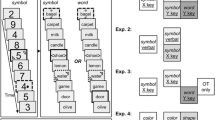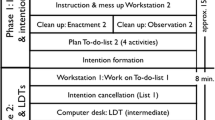Abstract
Previous studies have shown that completed prospective memory (PM) intentions entail aftereffects in terms of ongoing-task-performance decrements in trials containing repeated PM cues which previously served as PM cues triggering the intended action. Previous research reported that PM aftereffects decrease over time, thus revealing a specific time course of PM aftereffects. In the present study, we tested two accounts for this pattern, assuming either that the decline of aftereffects is related to the temporal distance to PM task completion or may be a result of the repeated exposure of repeated PM cues in the ongoing task. In three experiments, we manipulated both the temporal distance to PM task completion and the frequency of repeated PM cues and demonstrated that aftereffects of completed intentions declined with repeated exposure of formerly relevant PM cues. In addition, effects of repeated exposure were not only limited to the repetition of specific PM-cue exemplars but also generalized to other semantically related PM cues within the PM-cue category. Together, findings show that decreased aftereffects of completed intentions are not related to the temporal duration of the subsequent test block, but crucially depend on the repeated exposure of the previously relevant PM cues.



Similar content being viewed by others
Notes
The repeated cycles of PM and Test blocks differ to other approaches such as single-cycle paradigms (e.g., Scullin & Bugg, 2013). One could argue, e.g., that using repeated cycles, PM aftereffects may be overestimated when participants are ambiguous whether the intention has really finished and persist monitoring (Walser et al., 2012). In contrast, aftereffects may also be underestimated, because over the course of the experimental session, participants might learn to increasingly shield the ongoing task from deviant PMREPEATED and oddball stimuli during the Test blocks.
Sixteen participants participated in the experiment (1 male, age M = 22.56 years, SD = 4.08). In Test block 1, RTs on PM AREPEATED trials (M = 609 ms, SD = 121 ms) were slower than on oddball A trials (M = 550 ms, SD = 89 ms), F(1, 15) = 28.65, p < .001, η 2 = .66, indicating aftereffects of completed intentions (M = 59 ms). In Test block 2, no aftereffects were found for A-items (6 ms, PM AREPEATED trials: M = 553 ms, SD = 88 ms; oddball A: M = 547 ms, SD = 85 ms) nor for B-items (10 ms, PM BREPEATED trials: M = 548 ms, SD = 79 ms; oddball B: M = 538 ms, SD = 80 ms). The factor trial type was not significant. Also, Trial type × Item set did not interact, both Fs < 1.
We thank Julie Bugg for suggesting this analysis.
Although not significant, the at least numerically somewhat larger aftereffects in the 4 compared to the 12 PMREPEATED trials condition may be due to the task structure, as we cannot control for a potential imbalance of encountered oddball trials prior to the first 4 PMREPEATED trials in both conditions. It is conceivable, e.g., that in the 12 PMREPEATED trials condition participants have an increased experience of task-irrelevant deviants prior to the first 4 PMREPEATED trials, which should decrease aftereffects and RTs in trials including deviants in general (oddball trials and PMREPEATED trials alike). In fact, this is supported by a main effect of frequency, with faster responses to deviant trials in the high-frequency (12 repeat) condition compared to the low-frequency (4 repeat) condition.
This might have been caused by the increased number of post-deviant standard trials (i.e., 24) following the 24 deviant stimuli (12 PMREPEATED, 12 oddballs) in the high-frequency condition compared to the 8 post-deviant standard trials following the 8 deviant stimuli (4 PMREPEATED, 4 oddballs). Switching attention back from deviant stimuli to subsequent standard trials might have caused reorientation costs (see also Meier & Rey-Mermet, 2012). Re-analyzing standard trial RTs while excluding post-deviant standard trials strongly diminished the RT difference between low- and high-frequent conditions to a non-significant level, F(1, 23) = 2.71, p = .113, η 2 = .10.
We thank Michael Ziessler for raising this point.
We thank Julie Bugg for this suggestion.
References
Anderson, M. C., Bjork, R. A., & Bjork, E. L. (1994). Remembering can cause forgetting: Retrieval dynamics in long-term memory. Journal of Experimental Psychology: Learning, Memory, and Cognition, 20(5), 1063–1087. doi:10.1037/0278-7393.20.5.1063
Beck, S. M., Ruge, H., Walser, M., & Goschke, T. (2013). The functional neuroanatomy of spontaneous retrieval and strategic monitoring of delayed intentions (in revision).
Berman, M. G., Jonides, J., & Lewis, R. L. (2009). In search of decay in verbal short-term memory. Journal of Experimental Psychology: Learning, Memory, and Cognition, 35(2), 317–333. doi:10.1037/a0014873.
Bugg, J. M., Scullin, M. K., & McDaniel, M. A. (2013). Strengthening encoding via implementation intention formation increases prospective memory commission errors. Psychonomic Bulletin & Review, 20(3), 522–527. doi:10.3758/s13423-013-0378-3
Campoy, G. (2012). Evidence for decay in verbal short-term memory: A commentary on Berman, Jonides, and Lewis (2009). Journal of Experimental Psychology: Learning, Memory, and Cognition, 38(4), 1129–1136. doi:10.1037/a0026934.
De Baene, W., Kühn, S., & Brass, M. (2012). Challenging a decade of brain research on task switching: Brain activation in the task-switching paradigm reflects adaptation rather than reconfiguration of task sets. Human Brain Mapping, 33(3), 639–651. doi:10.1002/hbm.21234.
Einstein, G. O., & McDaniel, M. A. (1990). Normal aging and prospective memory. Journal of Experimental Psychology: Learning, Memory, and Cognition, 16(4), 717–726. doi:10.1037/0278-7393.16.4.717
Einstein, G. O., McDaniel, M. A., Thomas, R., Mayfield, S., Shank, H., Morrisette, N., et al. (2005). Multiple processes in prospective memory retrieval: Factors determining monitoring versus spontaneous retrieval. Journal of Experimental Psychology: General, 134(3), 327–342. doi:10.1037/0096-3445.134.3.327.
Förster, J., Liberman, N., & Higgins, E. T. (2005). Accessibility from active and fulfilled goals. Journal of Experimental Social Psychology, 41(3), 220–239. doi:10.1016/j.jesp.2004.06.009.
Goschke, T., & Kuhl, J. (1993). Representation of intentions: Persisting activation in memory. Journal of Experimental Psychology: Learning, Memory, and Cognition, 19(5), 1211–1226. doi:10.1037/0278-7393.19.5.1211.
Marsh, R. L., Hicks, J. L., & Watson, V. (2002). The dynamics of intention retrieval and coordination of action in event-based prospective memory. Journal of Experimental Psychology: Learning, Memory, and Cognition, 28(4), 652–659. doi:10.1037/0278-7393.28.4.652.
McBride, D. M., Beckner, J. K., & Abney, D. H. (2011). Effects of delay of prospective memory cues in an ongoing task on prospective memory task performance. Memory & Cognition, 39(7), 1222–1231. doi:10.3758/s13421-011-0105-0.
McDaniel, M. A., & Einstein, G. O. (2000). Strategic and automatic processes in prospective memory retrieval: A multiprocess framework. Applied Cognitive Psychology, 14(7), S127–S144. doi:10.1002/acp.775.
McKeown, D., & Mercer, T. (2012). Short-term forgetting without interference. Journal of Experimental Psychology: Learning, Memory, and Cognition, 38(4), 1057–1068. doi:10.1037/a0027749.
Meier, B., & Rey-Mermet, A. (2012). Beyond monitoring: After-effects of responding to prospective memory targets. Consciousness and Cognition, 21(4), 1644–1653. doi:10.1016/j.concog.2012.09.003.
Pink, J. E., & Dodson, C. S. (2013). Negative prospective memory: Remembering not to perform an action. Psychonomic Bulletin & Review, 20(1), 184–190. doi:10.3758/s13423-012-0337-4.
Rubin, D. C., & Wenzel, A. E. (1996). One hundred years of forgetting: A quantitative description of retention. Psychological Review, 103(4), 734–760. doi:10.1037/0033-295X.103.4.734.
Ruge, H., & Wolfensteller, U. (2010). Rapid formation of pragmatic rule representations in the human brain during instruction-based learning. Cerebral Cortex, 20(7), 1656–1667. doi:10.1093/cercor/bhp228.
Scullin, M. K., & Bugg, J. M. (2013). Failing to forget: Prospective memory commission errors can result from spontaneous retrieval and impaired executive control. Journal of Experimental Psychology: Learning, Memory, and Cognition, 39(3), 965–971. doi:10.1037/a0029198.
Scullin, M. K., Bugg, J. M., & McDaniel, M. A. (2012). Whoops, I did it again: Commission errors in prospective memory. Psychology and Aging, 27(1), 46–53. doi:10.1037/a0026112.
Scullin, M. K., Bugg, J. M., McDaniel, M. A., & Einstein, G. O. (2011). Prospective memory and aging: Preserved spontaneous retrieval, but impaired deactivation, in older adults. Memory & Cognition, 39, 1232–1240. doi:10.3758/s13421-011-0106-z.
Smith, R. E. (2003). The cost of remembering to remember in event-based prospective memory: Investigating the capacity demands of delayed intention performance. Journal of Experimental Psychology: Learning, Memory, and Cognition, 29(3), 347–361. doi:10.1037/0278-7393.29.3.347.
Walser, M., Fischer, R., & Goschke, T. (2012). The failure of deactivating intentions: Aftereffects of completed intentions in the repeated prospective memory cue paradigm. Journal of Experimental Psychology: Learning, Memory, and Cognition, 38(4), 1030–1044. doi:10.1037/a0027000.
Walser, M., Goschke, T., & Fischer, R. (2013). The difficulty of letting go: Moderators of the deactivation of completed intentions. Psychological Research. doi:10.1007/s00426-013-0509-5
Acknowledgments
We are grateful to Julia Kleindienst, Laura Pepernick and Sarah Richter for assistance in data collection. We thank Julie Bugg and Michael Ziessler for thoughtful comments on an earlier version of this manuscript. This research was partly supported by the German Research Foundation (DFG) (SFB 940/1-2013).
Author information
Authors and Affiliations
Corresponding author
Rights and permissions
About this article
Cite this article
Walser, M., Plessow, F., Goschke, T. et al. The role of temporal delay and repeated prospective memory cue exposure on the deactivation of completed intentions. Psychological Research 78, 584–596 (2014). https://doi.org/10.1007/s00426-013-0510-z
Received:
Accepted:
Published:
Issue Date:
DOI: https://doi.org/10.1007/s00426-013-0510-z




